Julie French: The unpredictable nature of stitch
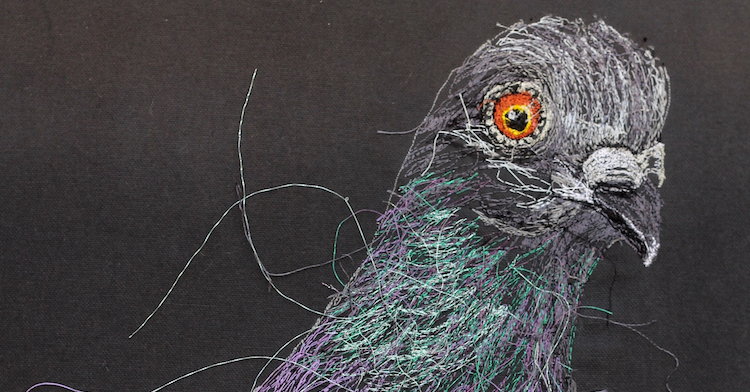
Using the sewing machine as a tool for continuous line drawing, Julie’s work explores movement and texture with often unpredictable outcomes, which have been likened to ink illustration.
Her work focuses on the wild side of nature, dance and motion. Each piece is unique and one off. The speed and capricious nature of the sewing machine, when used in this unconventional way reflect characteristics of the subjects.
Using reclaimed fabric, paper and handmade felt open new opportunities to discover how the stitched marks respond to different surfaces, pulling or embossing a piece of work in sympathy with the surface. Threads are purposely left loose over or around the image to allow the illusion of more depth and movement.
In this interview, Julie explains how reclaimed fabric, thread and her trusty Bernina all combine to produce her remarkable designs. We learn why travel was an instrumental pathway to her becoming an artist and how Julie finds inspiration from her students and Alfred’s racing pigeons.
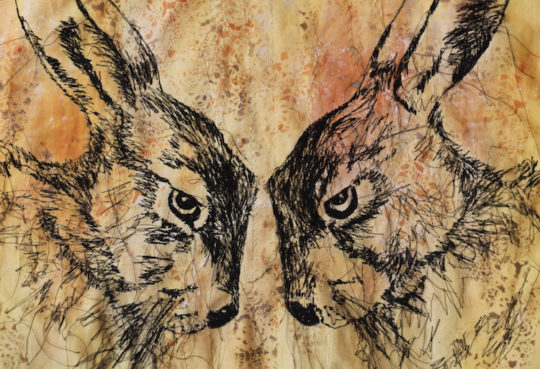
Julie French, Hare Stare Stand Off, 2017, 50 cm x 60 cm, machine stitch with ink stencil on calico
A myriad of opportunity
TextileArtist.org: What initially attracted you to textiles as a medium?
Julie French: I think what initially attracted me to textiles was the myriad of opportunities available through using the medium in so many different ways.
In my 20’s I spent as much of my time as possible, travelling through Europe, Asia and North Africa. In Morocco, I remember being fascinated by Berber Textiles being woven and huge vats of dye being stirred to create beautiful vibrant cloth as well as visiting markets saturated with colour and pattern.
In Turkey I came across an exhibition showcasing the huge mix media work by the artist Ilhami Atalay, even though they were not textile pieces, they were heavily influenced by the patterns and textures of traditional Turkish rugs and I loved the way fine art and textiles were merged.
It was when I returned from travelling in India that I decided to embark on a Degree in Printed Textiles and Surface Decoration.
And, more specifically, how was your imagination captured by stitch?
I love textures and layers and although you can achieve this with paint, stitch can really encourage the viewer to speculate on how the work was achieved.
I’m enticed by the unpredictable nature of stitch and the way it responds to the surface you apply it to. I’m always learning through experimentation, and even though I might use the same drawing multiple times, by using different surface no outcome is ever the same.
All my work is created with the sewing machine, and anyone who uses a sewing machine will know they can test you, but sometimes those moments of the machine deciding to do something you hadn’t planned can result in a unique and cherished outcome.
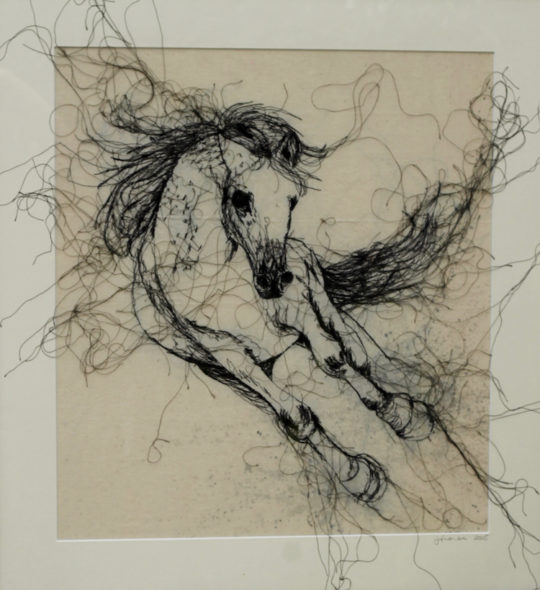
Julie French, Crazy Mare, 2016, machine stitch and ink on calico
Special childhood memories
What or who were your early influences and how has your upbringing influenced your work?
My Nan used to have a beautiful old singer machine in her garden; it was one of those ones fixed onto a wooden table with a metal pedal. It hadn’t been used for years and I would spend quite a lot of time playing with it. My mum spotted my passion for sewing machines and bought me a little plastic machine, I can’t remember the make, but I used it to make ill-fitting clothes for my Sindy and Tiny Tears dolls.
My mum was very creative; she made a lot of our clothes, always knitting or on the sewing machine. She helped my sister and I make an entire farm by painting fields, ponds and streams on a large piece of chipboard, complete with paper mache hills, on the reverse side we painted roads for our matchbox cars! My dad worked at a paper factory, so my sisters and I were always making use of the boxes of paper he brought home, playing drawing games and drawing posters of our favourite pop stars.
This year I have stitched birds that have special childhood memories. Alfred is a tribute my granddad Alfred O’Leary who I hold very fond memories of. He raced pigeons; the rear of my grandparent’s garden was full of huge sheds where the pigeons lived. My sisters and I always refer to pigeons we see as Granddad.
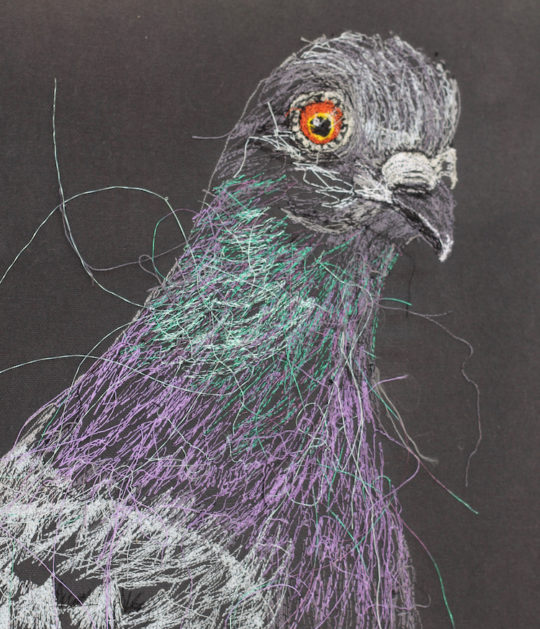
Julie French, Alfred (detail) 2017, 76 cm x 66 cm, machine stitch on furnishing fabric
Tinkerbelle is inspired by the budgies we had when we were small. We had a number of green and yellow budgies and they were all called Tinkerbelle. I think it was our parents hope that we would believe Tinkerbelle was the same bird throughout our childhoods and hadn’t escaped or died! Everyone seemed to have budgies in the 70’s, absolutely cruel, I realise now, but at the time it was very common.
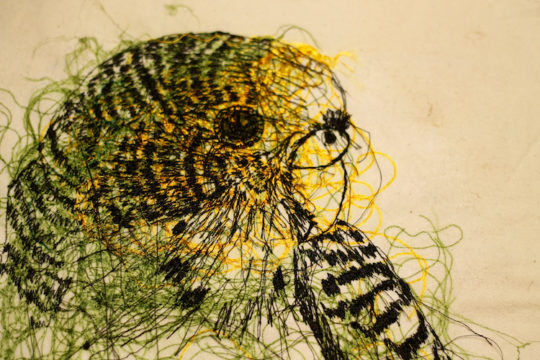
Julie French, Tinkerbelle, 2017, 32 cm x 32 cm, machine stitch with banana fibres on calico
What was your route to becoming an artist?
Art was always my favourite lesson at school and when I left I took a Diploma in Art and Design. I wanted to be a fine artist but my tutors told me my strongest area was Textiles. I loved experimenting with found objects and manipulating surfaces with heat, piecing and weaving, but I still wanted to be a painter.
After the course, I began working as a mental health support worker but continued to paint and did the odd painting commission. It wasn’t until I was 25 years old, after returning from 5 months of travelling around India, that I decided to apply for a degree course in Printed Textiles and Surface Decoration. I turned up to the interview with a mixture of life drawings and a few screen prints but I was still buzzing from the textiles I had seen in India, and the course leader pretty much gave me a place because of my enthusiasm and passion for the subject.
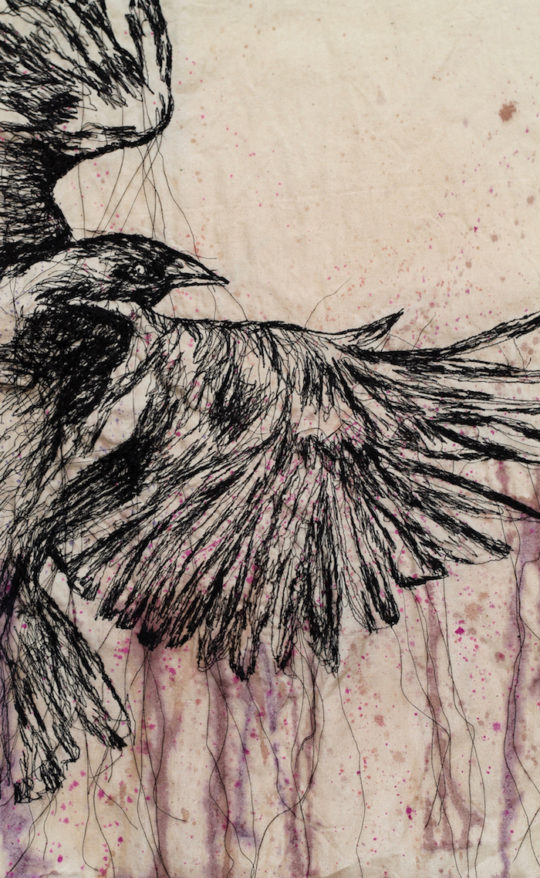
Julie French, Flight, 2015, machine stitch with ink on calico
After my degree, I worked freelance for a few fashion design agents, but I felt uninspired and restricted making flat repeat patterns. After a short stint of prop and set sculpting and painting I decided to take a job as an Art technician. I was really inspired by the teachers and decided to train to become an Art teacher. I have now been teaching for 14 years, and feel it has really helped me grow and develop as an artist.
Introducing Textile Art techniques and watching students realise the extensive ways they can use a process and create personal and fantastically unique outcomes is an inspiration every day.
My first exhibition happened a bit by chance. I had bought a piece of artwork from a friend and when he delivered the work he saw some of mine and asked if I wanted to join an exhibition he was in the process of curating. My work proved to be very popular and I really enjoyed talking to people about it, I also sold quite a few pieces. That experience was a real turnaround for me in considering myself as an artist.
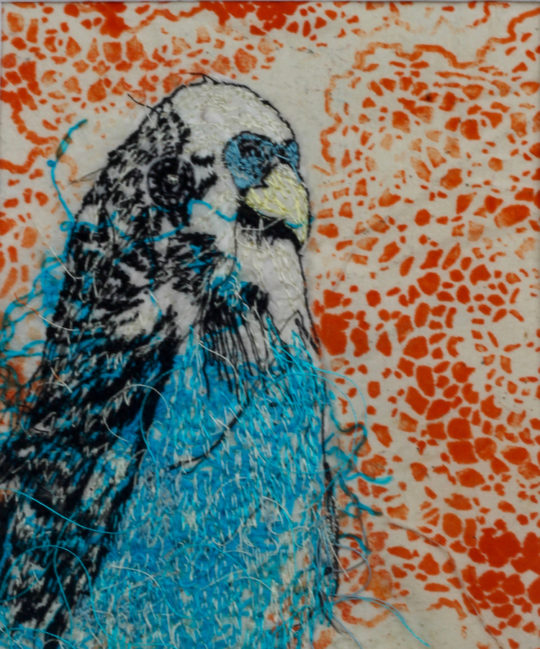
Julie French, Budgie, 2017, 15 cm x 20 cm, machine stitch and banana fibres with ink stencil on calico
Creating an illusion of movement
Tell us a bit about your chosen techniques.
All of my work is created using free motion machine embroidery. I often use reclaimed fabrics to draw on; sometimes I might build on the background using trapped fibres, felt or papers, which creates a good surface for creating embossed textures and detail. I leave threads loose to create an illusion of movement.
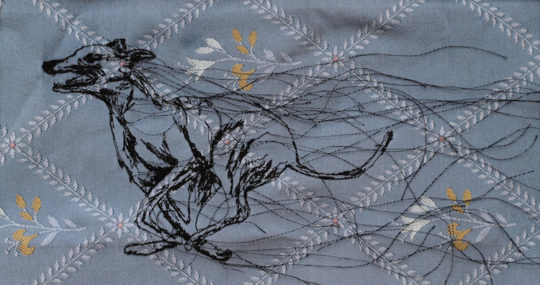
Julie French, Greyhound, 2014, 60 cm x 25 cm, machine stitch on reclaimed fabric
How would you describe your work and where do you think it fits within the sphere of contemporary art?
I would describe most of them as stitched illustrations, but I do explore a range of papers, bonding techniques, stencilling and ink too, so I would probably fit into the umbrella of mixed media.
Do you use a sketchbook? If not, what preparatory work do you do?
I don’t use a sketchbook to plan compositions; I prefer to make a drawing and then test out a technique or process if I am trying out something new. I have drawers full of drawings, photos, and background materials. I do have sketchbooks full of experiments, but I use those mostly for my teaching practice, to share them with students.
I do have sketchbooks full of experiments, but I use those mostly for my teaching practice, to share them with students.
What environment do you like to work in?
I am lucky enough to be able to work at home in the conservatory of my flat. My sewing machine obviously doesn’t take up too much space, but I do have quite a collection of different fabrics in my storage unit. I listen to the radio whilst I’m working, quite loud, so I can hear it over the sewing machine! The light is great in the day and the conservatory looks over the garden, so it is a perfect setting really.
I listen to the radio whilst I’m working, quite loud, so I can hear it over the sewing machine! The light is great in the day and the conservatory looks over the garden, so it is a perfect setting really.
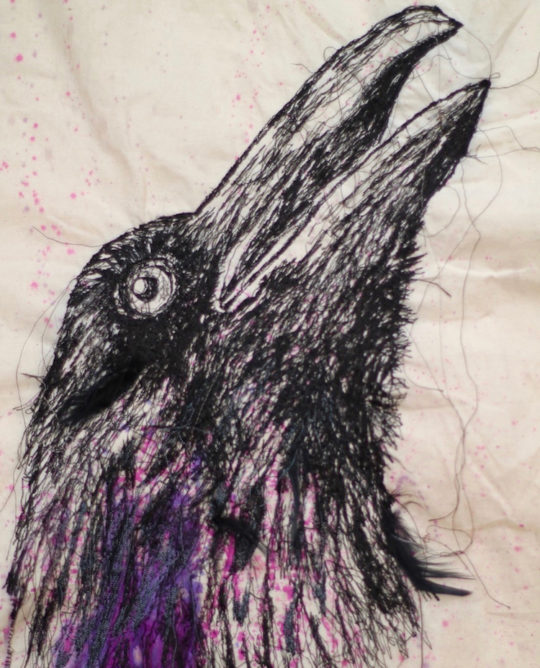
Julie French, Crow, 2015, 30 cm x 40 cm, machine stitch with ink on calico
A juggling act
What currently inspires you?
Students continue to inspire me on a daily basis, most of all the ones who choose Textile Art as an option. On a couple of occasions schools I have worked in have lost Textiles from the curriculum, each time I have fought for and promoted Textile Art and managed to get it back again. It’s a real worry that it could just disappear from schools and I see it as my duty not to let that happen! Juggling teaching and my own work are hard, but both are equally valuable to me.
Who have been your major influences and why?
Rosie James, Cas Holmes and Karen Nicol have been hugely inspiring with their use of materials and techniques and Paula Rego’s work for its sinister qualities, I watched a documentary about her recently and it was intriguing to hear her talk about how her art helped her to cope with her mental illness. I think that is an important message to share.
Tell us about a piece of your work that holds particularly fond memories and why?
Hare Stare was the first piece of work at sold at my first exhibition. I have made a few variations of him, all from the same drawing, and with each version, his stare becomes a little more intense and sinister. I still love stitching him.
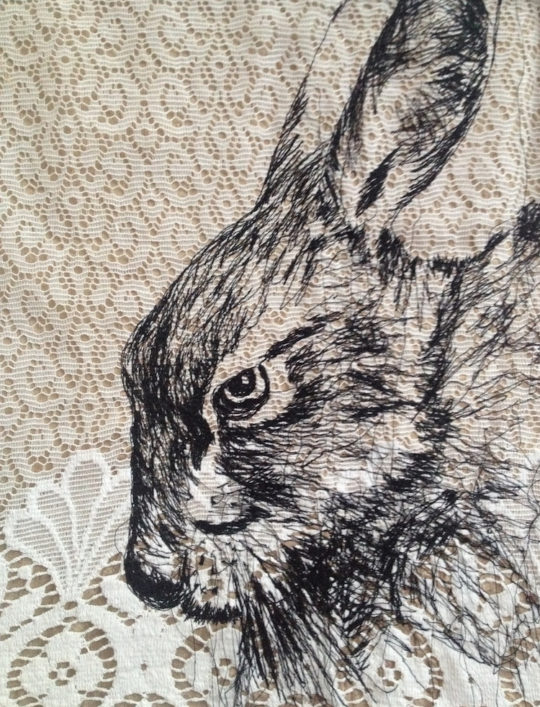
Julie French, Hare Stare (Curtain Twitcher), 2015, machine stitch on vintage lace
How has your work developed since you began and how do you see it evolving in the future?
I had begun only using black thread on mostly furnishing fabric, as the effect was bold and created strong movement with the thread being arranged around the subject.
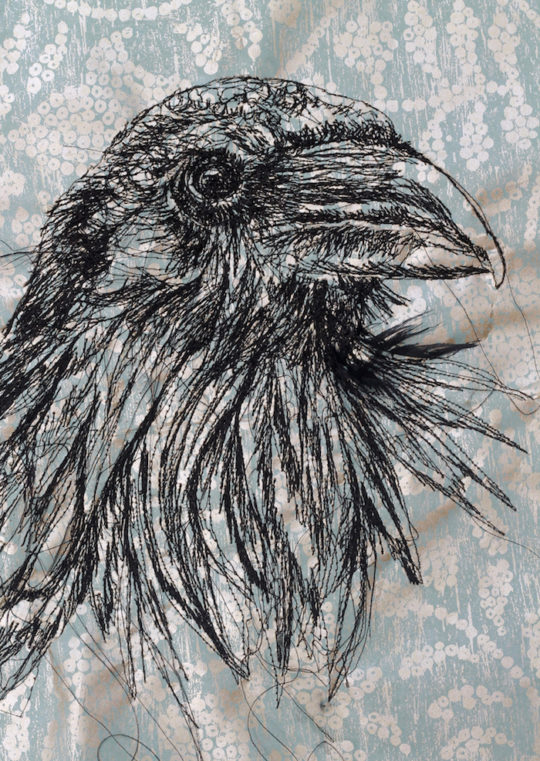
Julie French, Raven, 2017, 30 cm x 40 cm, machine stitch on metallic wallpaper
I began to introduce colour with ink and more recently have used bright banana fibres and coloured machine thread.
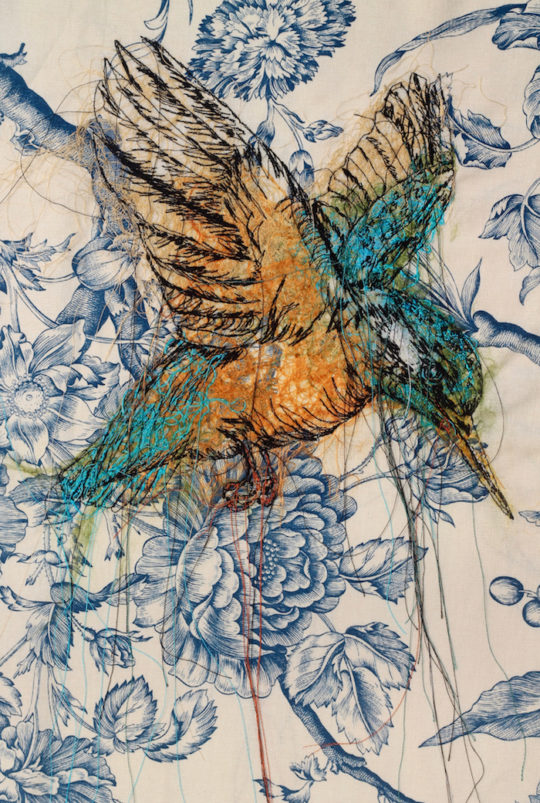
Julie French, Kingfisher, 2017, 32 cm x 47 cm, machine stitch and banana fibres on reclaimed furnishing fabric
Within my teaching practice, I explore a wider range of materials and techniques, using heat manipulation and bonding, often with more issue-based themes, I plan to take my own work in this direction next.
What advice would you give to an aspiring textile artist?
As a full-time Art teacher, teaching Textile Art, I always encourage my students to take risks with their experimentation, by doing this they find their own unique style. Take long walks with a camera. I take lots of photos, I don’t necessarily use the images in my work, but I think it boosts your awareness of the colours, textures, layers and pattern around you.
Have a thirst for discovering new artists; I always suggest to my students that they regularly look at TextileArtist.org for inspiration!
Shop or just take inspiration from flea markets, charity shops and boot sales, I have bought fantastic vintage lace and old maps that I regularly use in my work.
Get your work out there to be seen and try not to focus on making money.
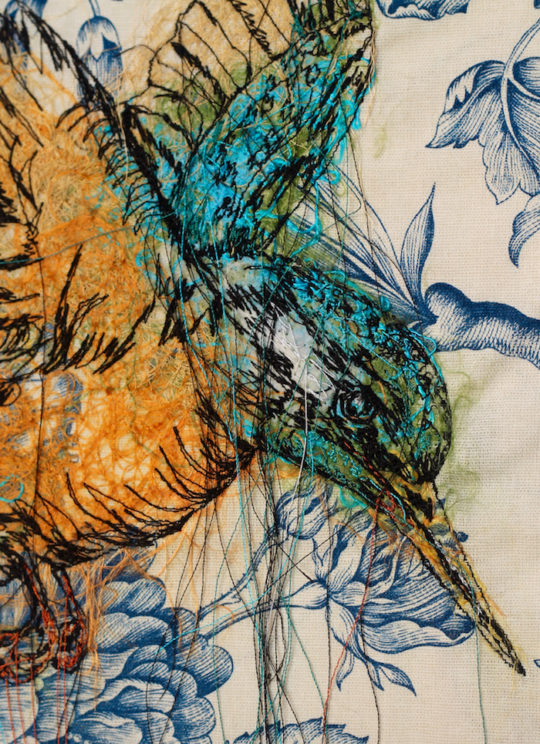
Julie French, Kingfisher (detail), 2017, 32 x 47 cm, machine stitch with banana fibres on reclaimed furnishing fabric
Can you recommend 3 or 4 books for textile artists?
The Found Object by Cas Holmes
Embellished: New Vintage by Karen Nicole
What other resources do you use? Blogs, websites, magazines etc.
As well as TextileArtist.org, Embroidery is a great magazine for discovering new artists and reading inspiring interviews. Pinterest is also a bit of an addiction.
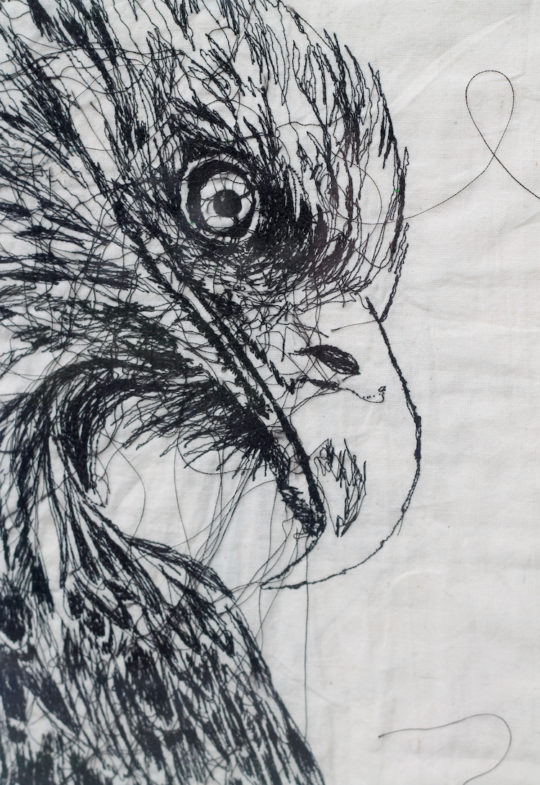
Julie French, Eagle, 2016, 40 cm x 50 cm, machine stitch on calico
What piece of equipment or tool could you not live without?
My Bernina
Do you give talks or run workshops or classes? If so where can readers find information about these?
I have delivered a few workshops for a local, non-profit organization called Sew Fabulous in Brighton.
Where can readers see your work this year?
Chelsea Psychic Garden Christmas Fair, London.
House of Illustration – Illustrators Christmas Fair, London.
IO Gallery, Brighton.
The World of Interiors – Artists Impression pages in the December 2017 and January 2018 issues
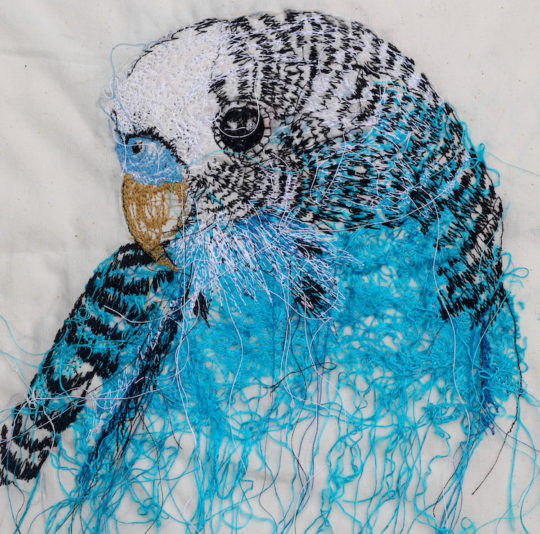
Julie French, Peter, 2017, 32 cm x 32 cm, machine stitch with banana fibres on calico
For more information visit: www.juliefrench.artweb.com, Instagram, Facebook, Pinterest and www.saatchiart.com
If you’ve enjoyed this interview why not share it with your friends on Facebook using the button below?
















Love this interview. Very inspiring!
Thank you!
Thank you Betty, that’s really nice to hear, I really enjoyed doing this interview
Where have you been all my life? Love your site!
Wonderful movement and expression in your work…So glad to have found it through this article on Textileartist. Love how there is always someone or something new to discover… honoured to be mentioned.
Hi Cas, It’s a fantastic website, it’s been inspiring me for years now, helping me discover new artist. Thank you for leaving a comment, as you also have been a great inspiration for years!
This is a wonder ! i don`t remember ever seeing such use of sewing machine stitching. i want to see more of those , they seem almost ready to fly away, they talk to me . thank you ! mirjam
Thank you for your lovely comments Mirjam
Beautiful! Your use of colour and the effect of wild threads on a geometric background is exciting. Thanks!
Thank you for your lovely comments Christiane
Your work is an inspiration to any textile artist. To capture that spontaneity with threads flying in contrast to their background. Your stitch drawings are amazing – thank you for sharing
Thank you so much Judy. It’s been an absolute pleasure to share. Thanks again for your very kind words.
Julie
I have such a love of your work, so simplistic yet complicated. Thread is such a great medium to work with. And the fibers you use as a canvas, inspiring. You give flight to your birds in my imagination.
Merci July de nous faire découvrir votre travail et . Quand j’apprécie une œuvre, j’ai des papillons dans le cœur. Cela a été le cas de vos réalisations. Votre travail sur le mouvement est vraiment incroyable. Vous avez su capter le Kingfisher alors que cet oiseau est si rapide. Fantastique votre travail avec l’utilisation de fibres de bananes ou l’utilisation de dentelles anciennes comme support. Cela me rapproche de la photographie sur le mouvement ou avec la macro des oiseaux qui m’entourent sur le bateau. J’apprécie vos souvenirs d’enfance et de la relation avec votre Grandad. Merci beaucoup de l’émotion de voir ce que vous réalisez et du plaisir de lire vos inspirations.
Amicalement
Béatrice